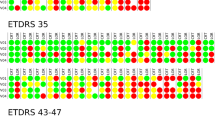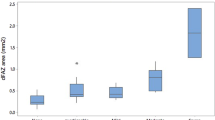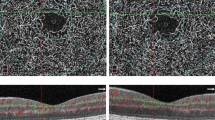Abstract
Objective
To assess if optical coherence tomography (OCT) and OCT angiography (OCTA) measures are associated with the development and worsening of diabetic retinopathy (DR) over four years.
Methods
280 participants with type 2 diabetes underwent ultra-wide field fundus photography, OCT and OCTA. OCT-derived macular thickness measures, retinal nerve fibre layer and ganglion cell-inner plexiform layer thickness and OCTA-derived foveal avascular zone area, perimeter, circularity, vessel density (VD) and macular perfusion (MP) were examined in relation to the development and worsening of DR over four years.
Results
After four years, 206 eyes of 219 participants were eligible for analysis. 27 of the 161 eyes (16.7%) with no DR at baseline developed new DR, which was associated with a higher baseline HbA1c and longer diabetes duration. Of the 45 eyes with non-proliferative DR (NPDR) at baseline, 17 (37.7%) showed DR progression. Baseline VD (12.90 vs. 14.90 mm/mm2, p = 0.032) and MP (31.79% vs. 36.96%, p = 0.043) were significantly lower in progressors compared to non-progressors. Progression of DR was inversely related to VD ((hazard ratio [HR] = 0.825) and to MP (HR = 0.936). The area under the receiver operating characteristic curves for VD was AUC = 0.643, with 77.4% sensitivity and 41.8% specificity for a cut-off of 15.85 mm/mm2 and for MP it was AUC = 0.635, with 77.4% sensitivity and 25.5% specificity for a cut-off of 40.8%.
Conclusions
OCTA metrics have utility in predicting progression rather than the development of DR in individuals with type 2 diabetes.
This is a preview of subscription content, access via your institution
Access options
Subscribe to this journal
Receive 18 print issues and online access
$259.00 per year
only $14.39 per issue
Buy this article
- Purchase on Springer Link
- Instant access to full article PDF
Prices may be subject to local taxes which are calculated during checkout

Similar content being viewed by others
Data availability
Data are available from the first author upon reasonable request.
References
Barber AJ, Lieth E, Khin SA, Antonetti DA, Buchanan AG, Gardner TW. Neural apoptosis in the retina during experimental and human diabetes. Early onset and effect of insulin. J Clin Investig. 1998;102:783–91.
de Carlo TE, Chin AT, Bonini Filho MA, Adhi M, Branchini L, Salz DA, et al. Detection of microvascular changes in eyes of patients with diabetes but not clinical diabetic retinopathy using optical coherence tomography angiography. Retina. 2015;35:2364–70.
Dimitrova G, Chihara E, Takahashi H, Amano H, Okazaki K. Quantitative retinal optical coherence tomography angiography in patients with diabetes without diabetic retinopathy. Investig Opthalmol Vis Sci. 2017;58:1766.
Takase N, Nozaki M, Kato A, Ozeki H, Yoshida M, Ogura Y, et al. Enlargement of foveal avascular zone in diabetic eyes evaluated by en face optical coherence tomography angiography. Retina. 2015;35:2377–83.
Mastropasqua R, Toto L, Mastropasqua A, Aloia R, De Nicola C, Mattei PA, et al. Foveal avascular zone area and parafoveal vessel density measurements in different stages of diabetic retinopathy by optical coherence tomography angiography. Int J Ophthalmol. 2017;10:1545–51.
Kirthi V, Reed KI, Alattar K, Zuckerman BP, Bunce C, Nderitu P, et al. Multimodal testing reveals subclinical neurovascular dysfunction in prediabetes, challenging the diagnostic threshold of diabetes. Diabetic Med. 2022. https://doi.org/10.1111/DME.14952.
Sun Z, Tang F, Wong R, Lok J, Szeto SKH, Chan JCK, et al. OCT angiography metrics predict progression of diabetic retinopathy and development of diabetic macular edema. Ophthalmology. 2019;126:1675–84.
Bressler NM, Edwards AR, Antoszyk AN, Beck RW, Browning DJ, Ciardella AP, et al. Diabetic Retinopathy Clinical Research Network. Retinal thickness on stratus optical coherence tomography in people with diabetes and minimal or no diabetic retinopathy. Am. J. Ophthalmol. 2008;145:894–901.
Early Treatment Diabetic Retinopathy Study Research Group. Photocoagulation for diabetic macular edema. Early Treatment Diabetic Retinopathy Study report number 1. Arch Ophthalmol. 1985;103:1796–806.
Diabetic Retinopathy Clinical Research Network, Krzystolik MG, Strauber SF, Aiello LP, Beck RW, Berger BB, Bressler NM, et al. Reproducibility of macular thickness and volume using Zeiss optical coherence tomography in patients with diabetic macular edema. Ophthalmology. 2007;114:1520–5.
Marques IP, Ferreira S, Santos T, Madeira MH, Santos AR, Mendes L, et al. Association between neurodegeneration and macular perfusion in the progression of diabetic retinopathy: a 3-Year Longitudinal Study. Ophthalmologica. 2022;245:335–41.
Tombolini B, Borrelli E, Sacconi R, Bandello F, Querques G. Diabetic macular ischemia. Acta Diabetol. 2022;59:751–9.
Boned-Murillo A, Albertos-Arranz H, Diaz-Barreda MD, Orduna-Hospital E, Sánchez-Cano A, Ferreras A, et al. Optical coherence tomography angiography in diabetic patients: a systematic review. Biomedicines. 2021;10:88.
Early Treatment Diabetic Retinopathy Study Research Group. Fluorescein angiographic risk factors for progression of diabetic retinopathy: ETDRS report number 13. Ophthalmology. 1991;98:834–40.
Ludovico J, Bernardes R, Pires I, Figueira J, Lobo C, Cunha-Vaz J. Alterations of retinal capillary blood flow in preclinical retinopathy in subjects with type 2 diabetes. Graefe’s Arch Clin Exp Ophthalmol. 2003;241:181–6.
Durbin MK, An L, Shemonski ND, Soares M, Santos T, Lopes M, et al. Quantification of retinal microvascular density in optical coherence tomographic angiography images in diabetic retinopathy. JAMA Ophthalmol. 2017;135:370–6.
Santos T, Warren LH, Santos AR, Marques IP, Kubach S, Mendes LG, et al. Swept-source OCTA quantification of capillary closure predicts ETDRS severity staging of NPDR. Br J Ophthalmol. 2022;106:712–8.
Marques IP, Kubach S, Santos T, Mendes L, Madeira MH, de Sisternes L, et al. Optical coherence tomography angiography metrics monitor severity progression of diabetic retinopathy—3-Year Longitudinal study. J Clin Med. 2021;10:2296.
Custo Greig E, Brigell M, Cao F, Levine ES, Peters K, Moult EM, et al. Macular and peripapillary optical coherence tomography angiography metrics predict progression in diabetic retinopathy: a sub-analysis of TIME-2b study data. Am J Ophthalmol. 2020;219:66–76.
Ratra D, Dalan D, Prakash N, Kaviarasan K, Thanikachalam S, Das UN, et al. Quantitative analysis of retinal microvascular changes in prediabetic and diabetic patients. Indian J Ophthalmol. 2021;69:3226–34.
Guo X, Chen Y, Bulloch G, Xiong K, Chen Y, Li Y, et al. Guangzhou Diabetic Eye Study Group. Parapapillary choroidal microvasculature predicts diabetic retinopathy progression and diabetic macular edema development: a three-year prospective study. Am J Ophthalmol. 2022:245:164–73.
Wang W, Cheng W, Yang S, Chen Y, Zhu Z, Huang W. Choriocapillaris flow deficit and the risk of referable diabetic retinopathy: a longitudinal SS-OCTA study. Br J Ophthalmol. 2022:bjophthalmol-2021-320704. https://doi.org/10.1136/bjophthalmol-2021-320704. Online ahead of print.
Funding
This work was supported by the DBT/Wellcome Trust India Alliance Fellowship [grant number IA/CPHE/16/1/502670] awarded to Sangeetha Srinivasan.
Author information
Authors and Affiliations
Contributions
SS, RRN, MPB involved in conceptualization of the study; SS involved in data analysis; SS, MPB involved in the drafting of the manuscript; SS, SSD, RR, RMA, RAM, VK, RRN, MPB involved in interpretation of results and in critical review of the manuscript.
Corresponding author
Ethics declarations
Competing interests
The authors declare no competing interests.
Additional information
Publisher’s note Springer Nature remains neutral with regard to jurisdictional claims in published maps and institutional affiliations.
Supplementary information
Rights and permissions
Springer Nature or its licensor (e.g. a society or other partner) holds exclusive rights to this article under a publishing agreement with the author(s) or other rightsholder(s); author self-archiving of the accepted manuscript version of this article is solely governed by the terms of such publishing agreement and applicable law.
About this article
Cite this article
Srinivasan, S., Sivaprasad, S., Rajalakshmi, R. et al. Association of OCT and OCT angiography measures with the development and worsening of diabetic retinopathy in type 2 diabetes. Eye 37, 3781–3786 (2023). https://doi.org/10.1038/s41433-023-02605-w
Received:
Revised:
Accepted:
Published:
Issue Date:
DOI: https://doi.org/10.1038/s41433-023-02605-w
This article is cited by
-
OCT angiography 2023 update: focus on diabetic retinopathy
Acta Diabetologica (2024)
-
Associations between retinal microvascular flow, geometry, and progression of diabetic retinopathy in type 2 diabetes: a 2-year longitudinal study
Acta Diabetologica (2023)



